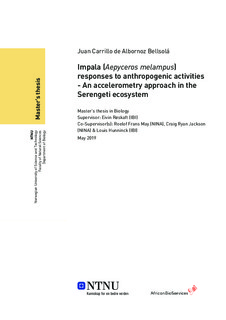| dc.contributor.advisor | Røskaft, Eivin | |
| dc.contributor.advisor | May, Roelof Frans | |
| dc.contributor.advisor | Jackson, Craig Ryan | |
| dc.contributor.advisor | Hunninck, Louis | |
| dc.contributor.author | Carrillo de Albornoz Bellsolá, Juan | |
| dc.date.accessioned | 2019-09-16T14:00:46Z | |
| dc.date.available | 2019-09-16T14:00:46Z | |
| dc.date.issued | 2019 | |
| dc.identifier.uri | http://hdl.handle.net/11250/2617052 | |
| dc.description.abstract | Menneskelig påvirkning av verneområder og nærliggende områder øker trykket på økosystemtjenestene som dyrelivet er avhengig av. I Serengeti er impala under konstant press fra mennesker på forskjellige måter avhengig av hvordan arealet blir utnyttet. I dette arbeidet ble impalas adferdsmønstre kartlagt og sammenlignet. Adferd ble sammenlignet mellom områder med turisme i Serengeti nasjonalpark og områder med tradisjonelt jordbruk i «Loliondo Game Controlled Area». Adferd ble kvantifisert med video-opptak og knyttet til data samlet gjennom et «to-akse akselerometer». K-nærmeste nabo-algoritme og «recursive partitioned decision tree» ble sammenlignet som klassifiseringsmetode for å evaluere akselerometerets evne til å identifisere forskjellige adferds kategorier. Verdier over 0.8 ble konsistent oppnådd for begge klassifikasjonsmetodene. Forskjellige adferds kategorier som; stasjonær, beiting of fødeopptak ble identifisert. Impala brukte mer tid på stasjonær adferd i områder med tradisjonelt jordbruk og i dagslys, men i mørket økte fødeopptaksaktiviteten med 74% i jordbruksområder sammenlignet med turistområder. Resultatene indikerer at impala kan tilpasse seg forskjellige former for menneskelig aktivitet. Dette arbeidet viser at bruk av aktivitets-sensorer som et verktøy kan være nyttig i bevaringsbiologi. | |
| dc.description.abstract | Human encroachment towards protected areas and their surroundings increases pressure on ecosystem services causing wildlife to adjust to a multitude of anthropogenic activities. In the Serengeti ecosystem, impala is subject to constant human-wildlife interactions whose nature may differ depending on the form of land-use encountered. This work examined differences in impala’s behavioural patterns under contrasting contexts of anthropogenic activity: High-end tourism in Serengeti National Park and traditional pastoralism to the adjacent Loliondo Game Controlled Area. Behavioural responses were quantified using video-recordings of impala behaviour coupled with activity records measured by two-axis accelerometers. The k-nearest neighbours’ algorithm and recursive partitioned decision trees were compared as classification methods to evaluate the ability of accelerometers to remotely identify behavioural categories. Overall high-performance metrics above 0.8 were consistently obtained for both classifiers. Behavioural categories Stationary, Feeding and Foraging were identified. Higher confidence unsupervised classifications of behavioural categories revealed impala to allocate more time to stationary behaviours in presence of pastoralists during the day, but to increase nocturnal foraging activity by 74% when comparing to touristed areas. These findings indicate adaptive responses of impalas towards different forms of anthropogenic exploitation, for which human habituation and temporal avoidance of livestock and pastoralists were suggested to be at the source of such adjustments. Furthermore, this work highlights the potential pertinence of activity sensors for their eventual use in conservation biology. | |
| dc.language | eng | |
| dc.publisher | NTNU | |
| dc.title | Impala (Aepyceros melampus) responses to anthropogenic activities - An accelerometry approach in the Serengeti ecosystem | |
| dc.type | Master thesis | |
